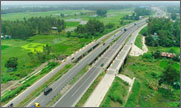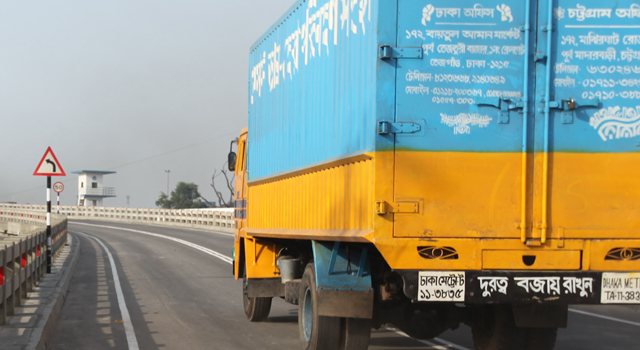Economic Corridor Development Results
Economic corridor development (ECD) involves the creation of an efficient multimodal transport network supported by quality infrastructure, logistics, and policy framework for ease of doing business, and distribution networks that link production centers, urban clusters, and international gateways, beyond the narrow space of a transport route. Individual SASEC countries are pursuing ECD to bring economic transformation and inclusive growth. SASEC support for economic corridors includes a regional approach in promoting synergies and identifying complementarities between national economic corridors and SASEC member countries, and improving cross-border links to optimize economic corridor investments.
ECD BANGLADESH
NEWS & MULTIMEDIA
total items: 13The Asian Development Bank (ADB) study on Bangladesh Economic Corridor Development assesses the economic potential of the northeast and southwest Bangladesh regions to propose the holistic development of the country to achieve inclusive and sustainable development.
Japan has proposed the development of a new industrial hub for the Bay of Bengal region. The hub, planned to be built in Bangladesh, will be equipped with supply chains that are connected to India's northeastern region. It will also be linked to Bhutan and Nepal through a planned port and transportation infrastructure.
Good connectivity reduces the cost of doing business and increases the competitive strengths of trading partners. In this commentary, Dr. Mustafizur Rahman, Executive Director, Centre for Policy Dialogue, highlights how a sanitary and phytosanitary agreement and an effective Bangladesh-Bhutan-India-Nepal Motor Vehicle Agreement would promote South Asian integration and step up Asia-wide cooperation.
The Ganges flows through the middle of Bihar, India, physically dividing it into north and south. Enhanced connectivity can improve lives and livelihoods, especially if the infrastructure is climate-sensitive. Ms. Saleha Waseem, Operations Communications Specialist at the Asian Development Bank’s South Asia Regional Department, shows how improving transport links would make a huge difference to millions of people.
India is set to join the Transports Internationaux Routiers (TIR), or International Road Transport Convention in its bid to establish seamless trade connectivity with Southeast Asia and Eurasian countries. Through the TIR Convention, India could access Eurasia via the International North-South Transport Corridor. TIR would also give India an advantage in trade with fellow signatories of the Bangladesh, Bhutan, India, Nepal (BBIN) Motor Vehicles Agreement.
The SASEC project portfolio has surpassed the $9 billion mark with the December 2016 approval of Nepal’s SASEC Roads Improvement Project, worth $256.5 million. There are now 44 SASEC investment projects worth a cumulative $9.13 billion. During 2016, seven projects have been approved for a total of $2.37 billion.
The six member countries of the South Asia Subregional Economic Cooperation Program have launched the SASEC Operational Plan for 2016-2025. The plan expands the program’s focus beyond intraregional cooperation to deepening linkages with Southeast and East Asia, and widens the scope of transport, trade facilitation, and energy cooperation to include economic corridor development as a priority initiative. The plan also lists more than 200 potential regional projects for South Asia.
The economic corridor development (ECD) strategy is an approach that integrates and synergizes industry, infrastructure, and urbanization through meticulous planning over a long-term horizon. An Asian Development Bank (ADB) blog post by Mr. Hoe Yun Jeong, Senior Economist (Regional Cooperation), South Asia Regional Department, published on 26 July 2016, shares how an ECD approach can be beneficial for the South Asia region.
The interactive SASEC Corridor Map on the SASEC Program website and SASEC Mobile App is your gateway to SASEC projects. View projects by sector—energy, transport, trade facilitation, and ICT—or by corridor using the interactive map, to learn how the SASEC program is helping promote regional prosperity in South Asia. The map also includes project information and links to SASEC project pages.
Dr. Selim Reihan notes that drivers of political economy can impact the region's integration agenda. In this essay, Dr. Raihan highlights the importance of exploring the political economy of regional integration to generate a better assessment of the factors driving and constraining regional integration, and create broader awareness among stakeholders to stimulate a more realistic and effective regional policy design and processes.
Major upgrades to modernize the Tangail-Rangpur Highway—which is part of the 1,741 kilometers (km) linking Bangladesh with the Asian Highway, and the Bangladesh-Bhutan-India-Nepal road network—are being proposed by Bangladesh Road and Highways Department, to include road widening and construction of bridges, flyovers, and culverts. The plan is currently being reviewed by Bangladesh Planning Ministry.
South Asia is set to play a strategic role in Asian integration. This commentary by Mr. Ganeshan Wignaraja, Advisor in the Asian Development Bank’s Economic Research and Regional Cooperation Department, shares how linking emerging South Asia with the more developed member countries of the Association of South East Asian Nations will transform regional economies through development of regional connectivity, and create a huge regional market of 2-3 billion people.
The Bangladesh-China-India-Myanmar Economic Corridor (BCIM-EC) – which received formal endorsement through an inter-governmental group meeting in December 2013 – could potentially bring significant benefits to the four countries by deepening economic cooperation and integration. BCIM-EC will increase socio-economic development and trade in South Asia.












